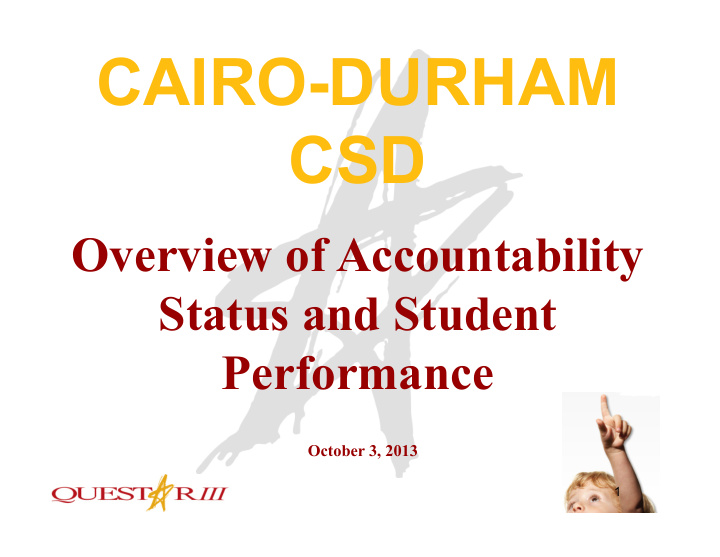



CAIRO-DURHAM CSD Overview of Accountability Status and Student Performance October 3, 2013 1
Accountability Status The district is designated as a Focus District The elementary and middle school buildings are designated as Focus Schools The high school is designated as a school in good standing 2
Differentiated Accountability Designations were based on AYP performance and growth using 2010-2011 school year as the base year In the first round districts/schools received focus designation for 3 years District/schools must show 2 consecutive years of positive performance to get off the Focus list 3
C-D Accountability 2011 did not make AYP • Students with disabilities sub-group • Economically disadvantaged sub-group 2012 did not make AYP • All students • White student sub-group • Students with disabilities sub-group • Economically disadvantaged sub-group 4
C-D Focus Designation On-site review process based on the Diagnostic Tool for School and District Effectiveness (DTSDE) Outside Educational Expert led reviews were completed for Durham Elementary and the Middle School last May 5
C-D Focus Designation Final Focus Review Reports for Durham Elementary and the Middle School last May were submitted to SED SED led reviews were conducted for Cairo Elementary and the District last June. Final reports have not yet been issued. 6
DTSDE Road Map DTSDE review provides the road map for school improvement based on 6 strategic areas called tenets • Tenet 1 – district leadership and capacity • Tenet 2 – school leadership • Tenet 3 – CCLS aligned curriculum development • Tenet 4 – CCLS aligned teacher practice • Tenet 5 – Student social & emotional support • Tenet 6 – Parent & community engagement 7
DTSDE Review Process Collection of “low inference” evidence • Pre-review document collection • School leader interviews • Teacher focus group interviews • Support staff interviews • Student focus group interviews • Parent focus group interview • Classroom visitations 8
C-D DTSDE Scoring HEDI ratings based on the DTSDE rubric Tenet 1 Ineffective • Major issue – district administrative turnover Tenet 2 Developing • Positive work on teacher feedback for APPR in first cycle of use • Need work on vision and goals 9
C-D DTSDE Scoring Tenet 3 Developing • Accelerate pace of CCLS curriculum development Tenet 4 Developing • Accelerate pace of CCLS aligned teacher practice through professional development 10
C-D DTSDE Scoring Tenet 5 Developing • Need to develop a comprehensive plan to address increasing student social and emotional development needs Tenet 6 Developing/Effective • Increase parent education and communication to foster higher levels of parent engagement 11
Common Core in New York 2010 : Board of Regents adopts Common Core State Standards 2013 : Common Core Assessments in Grades 3 – 8 ELA and Math are administered 2014 : Roll-out of Common Core Regents Exams begins • June 2014: ELA and Algebra I • June 2015: Geometry • June 2016: Algebra II Class of 2017 (2013 cohort) : First cohort of high school graduates required to pass Common Core Regents Exams for graduation Transition to New York Common Core Assessments is a seven year phase-in. EngageNY.org 12
English Language Arts 2009 – 2013 Grades 3-8 Combined Percentage of Students Scoring at Levels 3 and 4 The vertical lines indicate the years where the tests Number of Students Tested changed. In 2010, cut scores changed, but the 2009 2010 2011 2012 2013 standards and scale Grades 3-8: 1,200,460 1,196,283 1,195,432 1,192,129 1,182,266 remained the same. In 2013, the standards, scale, and cut scores changed to measure the Common Core. 31.1% Proficiency 13
Changes to NYS Assessments 2010 Changes 2013 Changes • Adoption of Career and • 100% alignment to CCLS College Ready • Change in scoring scale proficiency definition • Change in proficiency cut • Change in proficiency cut points points in scoring the assessments 14
English Language Arts 2009-2013 Percentage of Students Scoring at Level 1 Notice the Difference Between 2010 and 2013 15
16
C-D ELA 3-8 Performance Levels Versus NYS 17
2013 ELA Assessment Results Drill Down on Key Accountability Subgroups 18
English Language Arts 2009-2013 Economically Disadvantaged Comparisons Grades 3-8 Combined Percentage of Students Scoring at Levels 3 and 4 C-D 13.2% 19
English Language Arts 2009-2013 Students with Disabilities Comparisons Grades 3-8 Combined Percentage of Students Scoring at Levels 3 and 4 C-D 2.5% 20
21
Across grades 3-8, lower-need communities continued to outperform other areas of the State in ELA proficiency (NYS Levels 3 or 4) 22
New Performance Metrics Not just proficiency levels Student Growth Towards Proficiency (APPR/Accountability) C-D Opportunity Show Growth for Level 1 and Level 2 Students 23
Road Map for School Improvement Focus Review recommendations DCIP/SCEP plans are the district’s strategic plan for school improvement • Use the focus review recommendations • Describe specific goals and activities that support the recommendations Focus Reviews will be done this year and next to measure progress 24
Major Initiatives Update the district/schools vision and goals through a shared decision making committee (Tenet 2) CCLS Curriculum Plan (Tenet 3) CCLS aligned Professional Development Plan (Tenet 4) Create a Data Driven Instruction Plan to instructionally target specific student skill gaps (Tenets 3/4) 25
Major Initiatives Use of teacher common planning time (Tenet 4) Develop a comprehensive district-wide student support plan (Tenet 5) Create a community/parent engagement plan (Tenet 6) 26
QUESTIONS 27
Recommend
More recommend